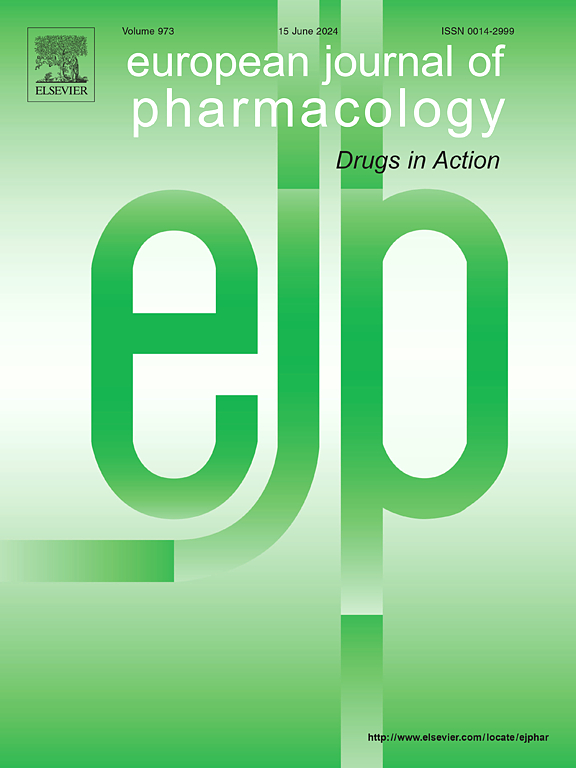Repeated treatment with JWH-018 progressively increases motor activity and aggressiveness in male mice: involvement of CB1 cannabinoid and D1/D2 dopaminergic receptors
IF 4.2
3区 医学
Q1 PHARMACOLOGY & PHARMACY
引用次数: 0
Abstract
Rationale
To date, the exposure to Synthetic Cannabinoids (SCs) has been linked to unanticipated psychiatric symptoms such as agitation, psychosis, and aggressive behavior. In line with this, preclinical studies have shown that acute and long-term exposure to these compounds can result in psychostimulant effects that may be related to CB1-mediated and dopamine-dependent mechanisms.
Objectives
This study focuses on the progressive effects induced by repeated injection of 1-pentyl-3-(1-naphthoyl)indole JWH-018 (6 mg/kg, i.p.) on the locomotor activity and aggressive behavior in adult male ICR-CD1® mice. Thus, the interaction with the cannabinoid CB1 receptor-preferring antagonist/inverse agonist AM-251 (6 mg/kg, i.p.), the dopamine D1/5 receptor antagonist SCH23390 (0.1 mg/kg, i.p.), and the dopamine D2/3 receptor antagonist haloperidol (0.05 mg/kg, i.p.) have been evaluated. Expression and distribution of D1 and D2 receptors and tyrosine hydroxylase (TH) have been also investigated by immunohistochemistry on brain and cerebellar samples to explore potential neuroplastic events.
Results
The repeated treatment with JWH-018 lead to the exacerbation of unanticipated psychomotor agitation, progressively increasing spontaneous locomotion and aggressiveness. Pre-treatment with AM-251 prevents the effects induced by the SC first, third and seventh injection. SCH23390 and haloperidol significantly attenuate and fully prevent the effects induced by JWH-018 seventh injection when pre-administered, respectively, alone and in combination. Behavioral changes observed in JWH-018-treated mice are accompanied by alterations in cortical, hippocampal, striatal and cerebellar D1, D2 and TH gene expression levels.
Conclusion
The present results demonstrated that repeated treatment with high dosage of JWH-018 induces psycho-stimulants effects via both CB1 receptor-mediated and dopamine-dependent mechanisms.

JWH-018的反复治疗逐渐增加雄性小鼠的运动活动和攻击性:CB1大麻素和D1/D2多巴胺能受体的参与
迄今为止,暴露于合成大麻素(SCs)已与意想不到的精神症状,如躁动,精神病和攻击行为有关。与此相一致,临床前研究表明,急性和长期暴露于这些化合物可导致精神兴奋作用,这可能与cb1介导和多巴胺依赖机制有关。目的研究反复注射1-戊基-3-(1-萘酰基)吲哚JWH-018 (6 mg/kg, i.p)对成年雄性ICR-CD1®小鼠运动活性和攻击行为的进行性影响。因此,对大麻素CB1受体首选拮抗剂/逆激动剂AM-251 (6 mg/kg, i.p)、多巴胺D1/5受体拮抗剂SCH23390 (0.1 mg/kg, i.p)和多巴胺D2/3受体拮抗剂氟哌啶醇(0.05 mg/kg, i.p)的相互作用进行了评估。D1和D2受体和酪氨酸羟化酶(TH)的表达和分布也通过免疫组织化学在脑和小脑样本中进行了研究,以探索潜在的神经可塑性事件。结果JWH-018反复治疗可导致未预料到的精神运动性躁动加重,自发性运动和攻击性逐渐增强。用AM-251进行预处理可防止SC第一次、第三次和第七次注射引起的影响。SCH23390和氟哌啶醇分别预给药、单独给药和联合给药时均能显著减弱和完全预防JWH-018第七针所致的不良反应。jwh -018处理小鼠的行为改变伴随着皮质、海马、纹状体和小脑D1、D2和TH基因表达水平的改变。结论反复使用高剂量JWH-018可通过CB1受体介导和多巴胺依赖机制诱导精神兴奋作用。
本文章由计算机程序翻译,如有差异,请以英文原文为准。
求助全文
约1分钟内获得全文
求助全文
来源期刊
CiteScore
9.00
自引率
0.00%
发文量
572
审稿时长
34 days
期刊介绍:
The European Journal of Pharmacology publishes research papers covering all aspects of experimental pharmacology with focus on the mechanism of action of structurally identified compounds affecting biological systems.
The scope includes:
Behavioural pharmacology
Neuropharmacology and analgesia
Cardiovascular pharmacology
Pulmonary, gastrointestinal and urogenital pharmacology
Endocrine pharmacology
Immunopharmacology and inflammation
Molecular and cellular pharmacology
Regenerative pharmacology
Biologicals and biotherapeutics
Translational pharmacology
Nutriceutical pharmacology.

 求助内容:
求助内容: 应助结果提醒方式:
应助结果提醒方式:


